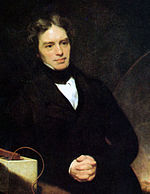Faraday's laws of electrolysis

Faraday's laws of electrolysis are quantitative relationships based on the electrochemical research published by Michael Faraday in 1833.[1][2] [3]
First law
Michael Faraday reported that the mass() of elements deposited at an electrode in g is directly proportional to the charge () in coulombs.[3]
Here, the constant of proportionality is called the Electro-Chemical Equivalent (e.c.e) of the substance. Thus, the e.c.e. can be defined as the mass of the substance deposited/liberated per unit charge.
Second law
Faraday discovered that when the same amount of electric current is passed through different electrolytes/elements connected in series, the mass of the substance liberated/deposited at the electrodes in g is directly proportional to their chemical equivalent/equivalent weight ().[3] This turns out to be the molar mass () divided by the valence ()
- (From 1st Law)
Derivation
A monovalent ion requires 1 electron for discharge, a divalent ion requires 2 electrons for discharge and so on. Thus, if electrons flow, atoms are discharged.
So the mass discharged
(where is Avogadros number)
(From Q = xe)
Where () is the Faraday constant.
Mathematical form
Faraday's laws can be summarized by
where is the molar mass of the substance (in grams per mol) and is the valency of the ions .
For Faraday's first law, , , and are constants, so that the larger the value of the larger m will be.
For Faraday's second law, , , and are constants, so that the larger the value of (equivalent weight) the larger m will be.
In the simple case of constant-current electrolysis, leading to
and then to
where:
- n is the amount of substance ("number of moles") liberated: n = m/M
- t is the total time the constant current was applied.
For the case of an alloy whose constituents have different valencies, we have
where wi represents the mass fraction of the ith element.
In the more complicated case of a variable electric current, the total charge Q is the electric current I() integrated over time :
Here t is the total electrolysis time.[4]
This section needs expansion with: Real-life application/worked out eg. of Faraday's Laws. You can help by adding to it. (August 2020) |
See also
References
- ^ Faraday, Michael (1834). "On Electrical Decomposition". Philosophical Transactions of the Royal Society. 124: 77–122. doi:10.1098/rstl.1834.0008. S2CID 116224057.
- ^ Ehl, Rosemary Gene; Ihde, Aaron (1954). "Faraday's Electrochemical Laws and the Determination of Equivalent Weights". Journal of Chemical Education. 31 (May): 226–232. Bibcode:1954JChEd..31..226E. doi:10.1021/ed031p226.
- ^ a b c "Faraday's laws of electrolysis | chemistry". Encyclopedia Britannica. Retrieved 2020-09-01.
- ^ For a similar treatment, see Strong, F. C. (1961). "Faraday's Laws in One Equation". Journal of Chemical Education. 38 (2): 98. Bibcode:1961JChEd..38...98S. doi:10.1021/ed038p98.
Further reading
- Serway, Moses, and Moyer, Modern Physics, third edition (2005), principles of physics.
- Experiment with Faraday's laws





























